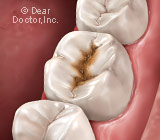 While some people associate the need for root canal treatment with an injury or trauma to a tooth (which is a valid cause), it can also most commonly be caused by tooth decay that is left untreated. This is the reason why we have put together this brief guide to explain the three common stages of tooth decay that lead up to the need for a root canal.
While some people associate the need for root canal treatment with an injury or trauma to a tooth (which is a valid cause), it can also most commonly be caused by tooth decay that is left untreated. This is the reason why we have put together this brief guide to explain the three common stages of tooth decay that lead up to the need for a root canal.
Stage 1: During this stage, decay begins to form in the tiny grooves on the biting surface of a tooth or where the teeth contact each other. The result is loss of the surface enamel of the tooth.
Stage 2: Left untreated, the disease progresses through the enamel and into the dentin, which forms the body of the tooth. Once in the dentin, it progresses more rapidly until it reaches the pulp — the living tissue within the root canals of the tooth. The decay infects the pulp tissues, which contain the nerves of the teeth, causing pain. The end result of inflammation and infection of the pulp is that it dies.
Stage 3: As the nerve dies an infection results, which causes pain and swelling. For some people who do not regularly visit our office, this may be the first physical sign that they have a problem. But all is not lost, a successful root canal treatment, whereby the infected pulpal tissue is removed and the root canals are cleaned and sealed will not only relieve the pain, but save your tooth. So the good news is that once a tooth has had the appropriate endodontic treatment (“endo” – inside; “dont” – tooth) followed by a proper restoration, the tooth can last as long as your other teeth. The key is to take proper care of your teeth, have routine cleanings, and visit our office as soon as you feel you have a problem with a tooth.
If you are having pain or symptoms from a tooth or teeth, check it out with us — you may or may not need a root canal treatment. Contact our office to schedule an appointment and find out. Don’t wait until it’s too late. And to learn more about the signs, symptoms, and treatments for a root canal, read the article “I’d Rather Have A Root Canal….”



